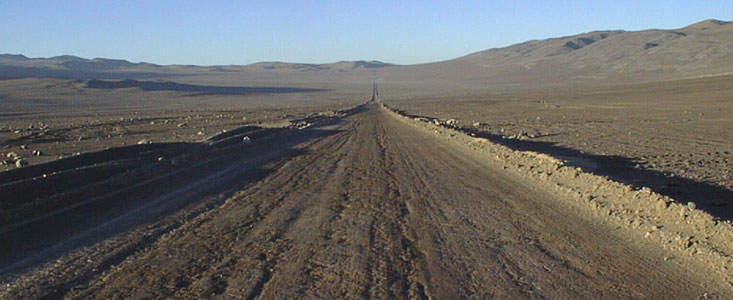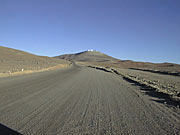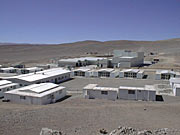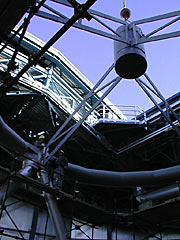Nota de prensa
Improving Access to the Paranal Observatory
10 de Septiembre de 1997
In this continuing series of views from the ESO Paranal Observatory, most have been related to developments around the VLT telescopes and their enclosures. While this assembly work is very important and now rapidly progresses towards the crucial moment of First Light, other activities are also going on which will ensure the proper functioning of the small, isolated community at Paranal, in the middle of the extreme Atacama desert.
One of the many tasks now underway is to improve the gravel road that leads to Paranal and on which all supplies are brought to the observatory. Anybody who has experienced the 130 km ride from Antofagasta to Paranal, especially the last stretch of road known as the Old Panamericana, would agree that the state of this `desert trail' is less than optimally suited for the safe transport of fragile goods, not to speak about the observatory staff!
Consequently, road work is now being carried out under an agreement between ESO, the Yolanda Mine (situated further to the south along that road) and the Direccion de Vialidad of the Chilean Ministerio de Obras Publicos (Public Works). Each partner is providing machinery, materials and people during an initial period of five months in order to improve significantly the condition of this important road. Yolanda and ESO provide assistance, but since it is a public road, the responsibility for this work rests with the Vialidad.
According to the Agreement, the improvements will be carried out between kms 15-33 and 45-72, as measured southwards from the junction between the `Old' and `New' Panamericana Road, some 60 kms south of Antofagasta. The improvements consist of grading, salt stabilizing and rolling. At this moment, a section of 23 kms has been completed, starting at the Paranal Observatory and moving back towards Antofagasta. Five more will be completed by the end of next week. This part of the road is now wide enough for two vehicles to pass each other easily and the surface is sufficiently good for driving speeds of up to about 90 km/hr to be maintained in safety.
The present series shows two images from the roads near Paranal as well as two views of the base camp site as it now presents itself after a lot of construction work. There is also one photo of the spider, now installed on the top of the mechanical structure of Unit Telescope 1.
Please note that since these images were electronically recorded and were primarily obtained to document the VLT construction activities, they may not be of sufficient quality for all reproduction purposes.
Acerca de la nota de prensa
| Nota de prensa No.: | eso9724 |
| Legacy ID: | Photo 26a-f/97 |
| Nombre: | Atacama Desert, Cerro Paranal, Paranal |
| Tipo: | Unspecified : Technology : Observatory |
| Facility: | Very Large Telescope |
Our use of Cookies
We use cookies that are essential for accessing our websites and using our services. We also use cookies to analyse, measure and improve our websites’ performance, to enable content sharing via social media and to display media content hosted on third-party platforms.
ESO Cookies Policy
The European Organisation for Astronomical Research in the Southern Hemisphere (ESO) is the pre-eminent intergovernmental science and technology organisation in astronomy. It carries out an ambitious programme focused on the design, construction and operation of powerful ground-based observing facilities for astronomy.
This Cookies Policy is intended to provide clarity by outlining the cookies used on the ESO public websites, their functions, the options you have for controlling them, and the ways you can contact us for additional details.
What are cookies?
Cookies are small pieces of data stored on your device by websites you visit. They serve various purposes, such as remembering login credentials and preferences and enhance your browsing experience.
Categories of cookies we use
Essential cookies (always active): These cookies are strictly necessary for the proper functioning of our website. Without these cookies, the website cannot operate correctly, and certain services, such as logging in or accessing secure areas, may not be available; because they are essential for the website’s operation, they cannot be disabled.
Functional Cookies: These cookies enhance your browsing experience by enabling additional features and personalization, such as remembering your preferences and settings. While not strictly necessary for the website to function, they improve usability and convenience; these cookies are only placed if you provide your consent.
Analytics cookies: These cookies collect information about how visitors interact with our website, such as which pages are visited most often and how users navigate the site. This data helps us improve website performance, optimize content, and enhance the user experience; these cookies are only placed if you provide your consent. We use the following analytics cookies.
Matomo Cookies:
This website uses Matomo (formerly Piwik), an open source software which enables the statistical analysis of website visits. Matomo uses cookies (text files) which are saved on your computer and which allow us to analyze how you use our website. The website user information generated by the cookies will only be saved on the servers of our IT Department. We use this information to analyze www.eso.org visits and to prepare reports on website activities. These data will not be disclosed to third parties.
On behalf of ESO, Matomo will use this information for the purpose of evaluating your use of the website, compiling reports on website activity and providing other services relating to website activity and internet usage.
Matomo cookies settings:
Additional Third-party cookies on ESO websites: some of our pages display content from external providers, e.g. YouTube.
Such third-party services are outside of ESO control and may, at any time, change their terms of service, use of cookies, etc.
YouTube: Some videos on the ESO website are embedded from ESO’s official YouTube channel. We have enabled YouTube’s privacy-enhanced mode, meaning that no cookies are set unless the user actively clicks on the video to play it. Additionally, in this mode, YouTube does not store any personally identifiable cookie data for embedded video playbacks. For more details, please refer to YouTube’s embedding videos information page.
Cookies can also be classified based on the following elements.
Regarding the domain, there are:
- First-party cookies, set by the website you are currently visiting. They are stored by the same domain that you are browsing and are used to enhance your experience on that site;
- Third-party cookies, set by a domain other than the one you are currently visiting.
As for their duration, cookies can be:
- Browser-session cookies, which are deleted when the user closes the browser;
- Stored cookies, which stay on the user's device for a predetermined period of time.
How to manage cookies
Cookie settings: You can modify your cookie choices for the ESO webpages at any time by clicking on the link Cookie settings at the bottom of any page.
In your browser: If you wish to delete cookies or instruct your browser to delete or block cookies by default, please visit the help pages of your browser:
Please be aware that if you delete or decline cookies, certain functionalities of our website may be not be available and your browsing experience may be affected.
You can set most browsers to prevent any cookies being placed on your device, but you may then have to manually adjust some preferences every time you visit a site/page. And some services and functionalities may not work properly at all (e.g. profile logging-in, shop check out).
Updates to the ESO Cookies Policy
The ESO Cookies Policy may be subject to future updates, which will be made available on this page.
Additional information
For any queries related to cookies, please contact: pdprATesoDOTorg.
As ESO public webpages are managed by our Department of Communication, your questions will be dealt with the support of the said Department.






